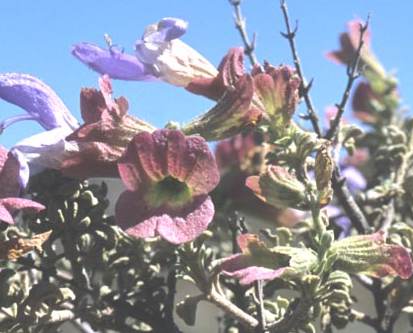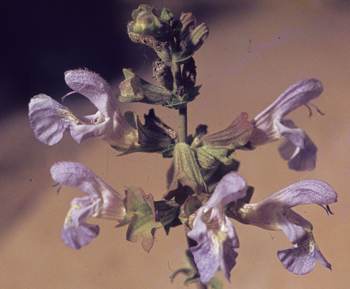Salvia dentata
Salvia dentata Aiton
Family: Lamiaceae
Common names: Toothed sage (Eng.); bergsalie, blousalie (Afr.)
Introduction
Salvia dentata is a wonderful, aromatic, evergreen shrub with prolific flowers suitable for water-wise gardens.

Description
Description
Fast-growing, erect, evergreen shrub 0.6-2 m high; neat with dense growth habit. Grey-green leaves and stems due to glandular hairs and oil globules on young growth which become glabrous (smooth) later. Stems are unusually round and not square which is a common sage family trait. Leaves curl upwards, narrow, irregularly shaped and variable. Calyx green or tinged with purple. Corolla light or dark purple, violet blue or white, 25 mm long; upper floral lip slightly downwardly curved with the lower lip flattened.

Flowers late winter to early summer (July-Jan). Black or dark brown, shiny seeds are visible at the base of the calyx and fall out when ripe.
Conservation Status
Status
Salvia dentata is not threatened.
Distribution and habitat
Distribution description
The toothed sage prefers dry slopes, rocky hillsides or watercourses and granite outcrops between Namaqualand and Clanwilliam, in the Western Cape of South Africa and can be found at altitudes of 150-1500 m.
Derivation of name and historical aspects
History
Salvia dentata was first described in 1789 by a Scottish botanist, William Aiton (1731-1793). Aiton was also a trained professional gardener, worked in London at the Chelsea Physic Garden and later in 1759 became the director at the Kew Botanic Garden. Salvia is derived from the Latin salvus, meaning uninjured, whole, safe, well or sound and salvere, to be in good health, referring to the medicinal value of the plants. The appellation dentata refers to this plant's toothed leaves, although they are variable.

Salvia is the largest genus in the Lamiaceae family and consists of approximately 900 species made up of annuals, perennials and shrubs. They are widely distributed around the world in warm temperate and tropical regions. Twenty-seven species are found naturally in South Africa. Noteworthy South African sages are Salvia africana-lutea, S. africana-caerulea, S. chamelaeagnea, S. muirii and S. dolomitica. Sages are commonly grown as ornamentals. The flowers of Salvia dentata are very similar to those of Salvia africana-caerulea, but the leaves are distinctive.
Ecology
Ecology
Bees and insects are attracted to Salvia flowers which are adapted to pollination by bees. The lower lip of the flower is a platform on which the bee lands. As the bee probes for nectar, it presses against the hinged filament of the stamen, which causes the stamen to move down and the anther to touch the bee, rubbing pollen onto the bee's back. When the bee enters another flower of the same species, the pollen will rub against the stigma of the other flower and, if receptive, cross pollination will be successful.

Uses
Use
Salvia dentata can be used as an attractive, summer-flowering shrub in any herbaceous border and is suitable for large or small gardens. This sage is a wonderful addition to any garden with its grey-green, pleasantly aromatic foliage which can be supplemented with other shrubs, herbaceous perennials or fynbos. It adds a calm grey hue to a garden planting which is complemented by its mauve flowers with their retained purple-tinged calyx, extending the summer display period. It is suitable as a foreground or background planting.
Although not highly recommended, they can make good container specimens if grown in large, well drained pots. Salvia dentata is a wonderful garden specimen, wind-hardy and water-wise.

Growing Salvia dentata
Grow
Salvia dentata is best grown in open ground in full sun. It requires well-drained, composted soils. The toothed sage will survive with little water, but responds well to regular watering, especially in summer. No extra feeding is necessary for strong, healthy growth in good soils, although an occasional foliar feed will do no harm and the plants will tolerate and respond well to general fertilizing. This sage is quite wind-hardy too. The plants can be pruned every year or alternatively every second year to encourage bushy, non-woody growth. This is best done in late winter, prior to its new spring growth.
Young plants are planted out at the end of spring. Salvia dentata is easily combined with most flowering perennials or shrubs which contrast with its grey foliage, such as Diascia integerrima, Pelargonium citronellum and Orphium frutescens. They also give good contrast with fynbos plants such as Restionaceae, Proteaceae and Erica species.
New plants are easy to propagate from seed and cuttings.Sow seeds in late spring and early summer into general potting soil mix. Seeds germinate quickly and seedlings can be transplanted into well-drained potting soil once the first pair of true leaves appears.
Take semi-hardwood tip cuttings in spring and summer. Cuttings must be without terminal flowering buds. A rooting hormone would improve the chance of root development. Place in rooting medium: 50% fine-milled bark and 50% polystyrene (perlite, vermiculite, river sand and peat are alternatives). Keep cuttings under mist or enclose in plastic bag to retain humidity. Keep warm but out of direct sunlight. Cuttings should root in 2-4 weeks.
Due to the hairy and aromatic leaves the plants do not have any major pest, although mealy bug may settle near the base of the stems and leaves.
References
- Clebsch, B. 1997. A book of Salvias: Sages for every garden . Timber Press, Oregon.
- Hedge, I.C. 1974. Revision of Salvia in Africa including Madagascar and Canary Islands. Notes from the Royal Botanic Garden Edinburgh 33(1).
- Smith, C.A. 1966. Common names of South African plants. Memoirs of the Botanical Survey of South Africa No. 35.
- http://redlist.sanbi.org .
Credits
Monique McQuillan
Kirstenbosch National Botanical Garden
April 2013
Plant Attributes:
Plant Type: Shrub
SA Distribution: Northern Cape, Western Cape
Soil type: Sandy
Flowering season: Spring, Early Summer, Winter
PH: Acid, Neutral
Flower colour: Pink, Mauve/Lilac
Aspect: Full Sun
Gardening skill: Average
Special Features:
Horticultural zones











Rate this article
Article well written and informative
Rate this plant
Is this an interesting plant?
Login to add your Comment
Back to topNot registered yet? Click here to register.